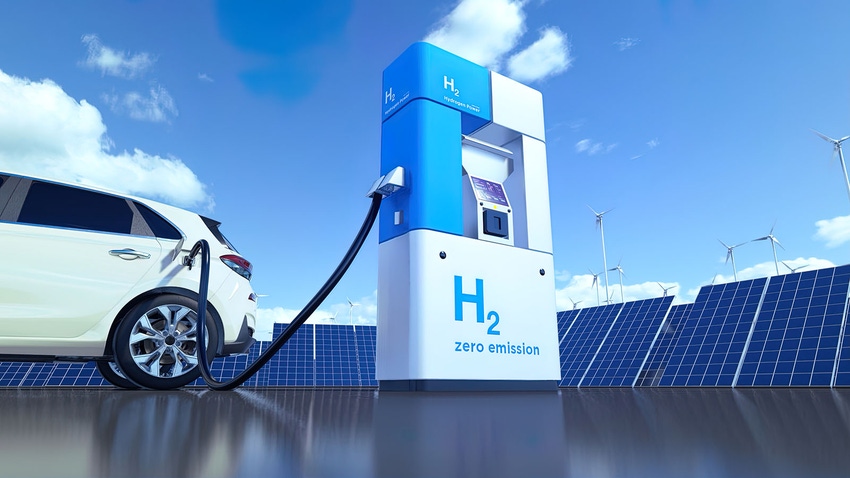Fuel-Cell Electric Vehicles Face Tremendous Hurdles in Market Penetration
IDTechEx analysis predicts fuel-cell electric vehicles will capture no more than 4% market share of zero-emission cars well into the future.
January 8, 2024

At a Glance
- Fuel-cell EVs offer drivers a much longer range compared with battery EVs
- Refueling of hydrogen tanks takes minutes, comparable with conventional internal combustion engine technology
- High cost limits market penetration
IDTechEx's latest report, “Fuel Cell Electric Vehicles 2024-2044: Markets, Technologies, and Forecasts,” explores the market for on-road fuel-cell electric vehicles (FCEVs), including cars, light commercial vehicles, medium- and heavy-duty trucks, and buses. The report covers the market drivers, barriers, players, technologies, models, benchmarking, and adoption for the next 20 years for unit sales, fuel cell demand, battery demand, and market value.
In response to the threat posed by climate change and poor urban air quality, many countries are tightening emissions regulations to reduce the impact from on-road transportation. This legislation is forcing OEMs away from traditional internal combustion engines (ICEs) and toward zero-emission powertrains. The two key technologies to achieve this are battery electric vehicles (BEVs) and FCEVs.
Range anxiety addressed with FCEV technology
While the market for pure BEVs is beginning to take off in many transport segments, the energy density limits of lithium-ion batteries means that the range is restricted both by the maximum weight of batteries that can be carried by a vehicle and the available space for batteries within that vehicle. Fuel-cell technologies offer automakers an avenue to greater vehicle range, whilst still delivering the crucial reduction in on-road exhaust emissions.
A further significant benefit of fuel-cell systems is that the refueling of hydrogen tanks is similar to refueling conventional combustion engine vehicles: Taking just a few minutes, it is considerably faster than comparatively slow electric charging, which can take several hours. The range and refueling advantage of FCEV technology could be particularly critical for the viability of zero-emission heavy-duty truck and bus operations, where there is a high daily range requirement, long operating hours, and the need for operational flexibility.
Toyota, Hyundai head development efforts
Progress in the passenger car market for fuel cells has largely been driven by Toyota and Hyundai, following the exit of Honda's Clarity in 2021. Many other major OEMs have made significant investments in the technology over the past 30 years, including Ford, GM, Volkswagen, Daimler, and BMW. Toyota and Hyundai accounted for the vast majority of global FC car sales in 2021 and 2022, with around 15,000 sales in each year. Progress has been driven by South Korea and the state of California. China is also seeing a growing interest in FC cars, with several OEMs now demonstrating models which, given the support from China for a hydrogen economy, could see future success.
High cost, lack of refueling infrastructure hinder market penetration
BEVs, whose development began in earnest at around the same time as FCEVs, sold more than 7.7 million units in 2022. While IDTechEx predicts fuel cell cars to experience growth over the forecast period, they will remain a very small portion of zero-emission cars, estimated at just 4%, with BEVs taking the majority share.
Fuel-cell vehicle deployment faces considerable challenges, including decreasing the cost of fuel-cell system components to reduce the upfront cost of fuel-cell vehicles, and rolling out sufficient hydrogen refueling infrastructure to make driving an FCEV workable. Also essential will be the availability of cheap 'green' hydrogen, produced by the electrolysis of water using renewable electricity. This will be vital for FCEVs to deliver on the environmental credentials on which they are being sold, according to analysis in the new IDTechEx report.
The most developed, cheapest, and scalable method currently available for hydrogen generation is steam methane (natural gas) reforming. Hydrogen produced by this method is known as "grey hydrogen." This process, however, produces a significant volume of CO2, meaning the well-to-wheel carbon footprint — all emissions related to fuel production, processing, distribution, and use — of FCEVs using grey hydrogen would offer a very limited emission reduction potential over modern combustion engine vehicles. The IDTechEx report looks at hydrogen and renewable energy generation to analyze the CO2 generated per kilometer for BEVs and FCEVs under various assumptions. FCEVs only make sense in terms of emission reduction if the hydrogen used is green; grey hydrogen makes them comparable to existing diesel engines.
Buses and heavy trucks show promise
Of particular focus in the IDTechEx report are the heavy-duty truck and bus markets, which operate under demanding applications that require a long daily range, have constrained refueling time availability, and require operational flexibility. Whilst this segment of the transport industry is also facing tightening legislative requirements to reduce exhaust emissions, BEV solutions are potentially less feasible in these applications, as the weight and cost of the lithium-ion battery required to deliver the daily-duty cycle are prohibitive. These applications offer a market segment where FCEVs could offer the only viable zero-emission solution. This new report looks in detail at the challenge of employing fuel-cell commercial vehicles, including CAPEX costs, the influence of hydrogen fuel cost on viability, and examples from current FCEV deployments.
About the Author(s)
You May Also Like



